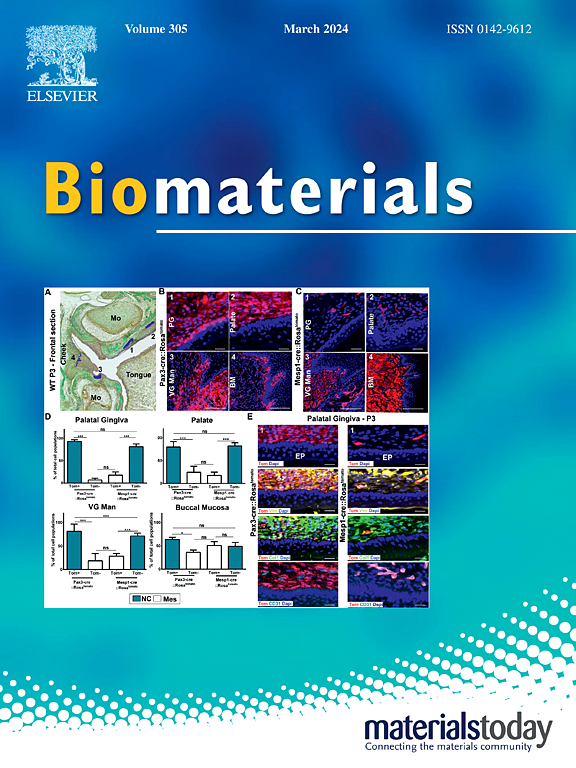A triple-responsive nanozyme platform of AgAu–CeO2 heterojunction integrated with probiotics for precision antibacterial therapy in periodontitis
IF 12.9
1区 医学
Q1 ENGINEERING, BIOMEDICAL
引用次数: 0
Abstract
Nanozymes hold significant promise for biomedical applications; however, their clinical translation is hindered by the mismatch between physiological conditions and their optimal catalytic environments, particularly with respect to temperature and pH. To address this challenge, we developed a multifunctional composite nanozyme (AgAu C-L, formed by covalent conjugation of AgAu@CeO2 with Lactobacillus reuteri) by anchoring an ultrasmall cerium dioxide (CeO2) nanozyme with peroxidase (POD)-like activity onto silver-gold nanocages (AgAu NCs), and integrating it with Lactobacillus reuteri (L. reuteri). Upon near-infrared light irradiation, the localized surface plasmon resonance effect of AgAu NCs induced dual regulatory mechanisms: photothermal heating, which elevated local temperature to enhance catalytic efficiency, and interfacial electron transfer, which promoted Ce3+/Ce4+ redox cycling to sustain catalytic activity. Simultaneously, L. reuteri modulated the local pH through the secretion of lactic and acetic acids, creating a favorable acidic microenvironment for enzyme function. This triple-modulation strategy markedly enhanced the POD-like activity of CeO2, triggering a robust reactive oxygen species burst that effectively disrupted periodontal biofilms and eliminated pathogenic bacteria. Furthermore, the composite interfered with microbial metabolic pathways, reducing biofilm formation and virulence. Our findings establish a powerful nanozyme-based platform for periodontitis treatment and provide a broadly applicable strategy for optimizing nanozyme performance in vivo.

AgAu-CeO2异质结结合益生菌的三重响应纳米酶平台用于牙周炎的精确抗菌治疗。
纳米酶在生物医学应用方面具有重大前景;然而,它们的临床转化受到生理条件和最佳催化环境之间不匹配的阻碍,特别是在温度和ph方面。为了解决这一挑战,我们通过将具有过氧化物酶(POD)样活性的超小型二氧化铈(CeO2)纳米酶锚定在银金纳米笼(AgAu NCs)上,开发了一种多功能复合纳米酶(AgAu C-L,由AgAu@CeO2与罗伊氏乳杆菌共价偶联形成)。并与罗伊氏乳杆菌(L. reuteri)结合。在近红外光照射下,AgAu纳米材料的局部表面等离子体共振效应诱导了双重调节机制:光热加热,通过提高局部温度来提高催化效率;界面电子转移,通过促进Ce3+/Ce4+氧化还原循环来维持催化活性。同时,罗伊氏乳杆菌通过分泌乳酸和乙酸调节局部pH,为酶的功能创造了良好的酸性微环境。这种三重调节策略显著增强了CeO2的pod样活性,引发了强大的活性氧爆发,有效地破坏了牙周生物膜并消灭了致病菌。此外,复合材料干扰微生物代谢途径,减少生物膜的形成和毒力。我们的研究结果建立了一个强大的基于纳米酶的牙周炎治疗平台,并为优化纳米酶在体内的性能提供了广泛适用的策略。
本文章由计算机程序翻译,如有差异,请以英文原文为准。
求助全文
约1分钟内获得全文
求助全文
来源期刊

Biomaterials
工程技术-材料科学:生物材料
CiteScore
26.00
自引率
2.90%
发文量
565
审稿时长
46 days
期刊介绍:
Biomaterials is an international journal covering the science and clinical application of biomaterials. A biomaterial is now defined as a substance that has been engineered to take a form which, alone or as part of a complex system, is used to direct, by control of interactions with components of living systems, the course of any therapeutic or diagnostic procedure. It is the aim of the journal to provide a peer-reviewed forum for the publication of original papers and authoritative review and opinion papers dealing with the most important issues facing the use of biomaterials in clinical practice. The scope of the journal covers the wide range of physical, biological and chemical sciences that underpin the design of biomaterials and the clinical disciplines in which they are used. These sciences include polymer synthesis and characterization, drug and gene vector design, the biology of the host response, immunology and toxicology and self assembly at the nanoscale. Clinical applications include the therapies of medical technology and regenerative medicine in all clinical disciplines, and diagnostic systems that reply on innovative contrast and sensing agents. The journal is relevant to areas such as cancer diagnosis and therapy, implantable devices, drug delivery systems, gene vectors, bionanotechnology and tissue engineering.
 求助内容:
求助内容: 应助结果提醒方式:
应助结果提醒方式:


